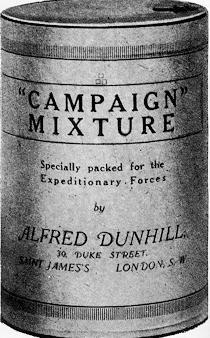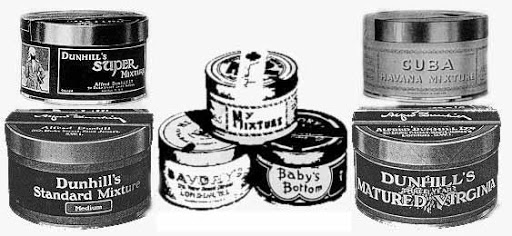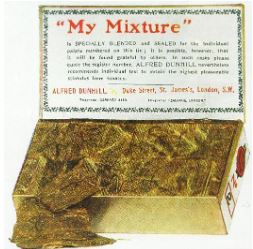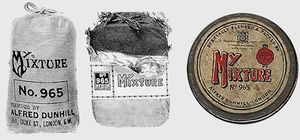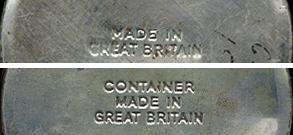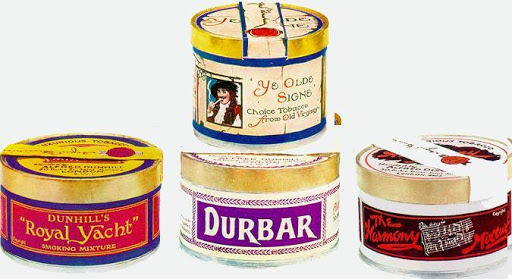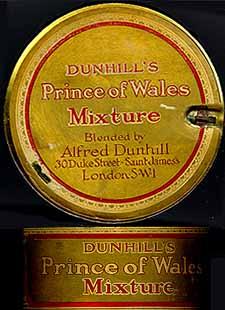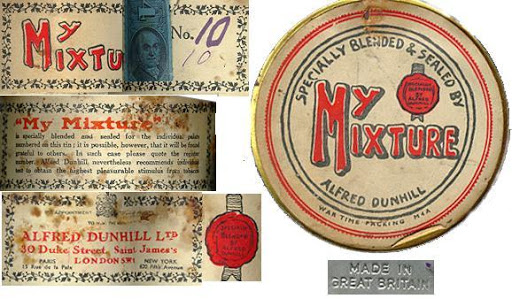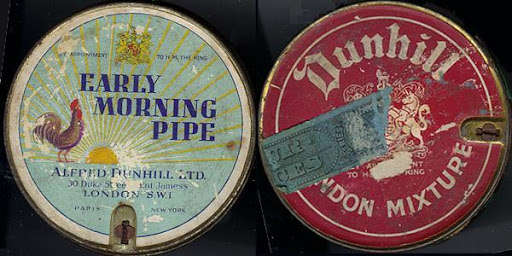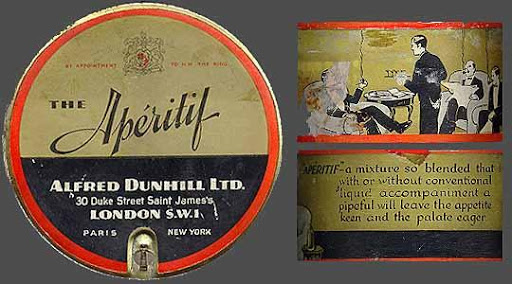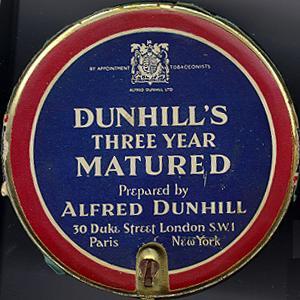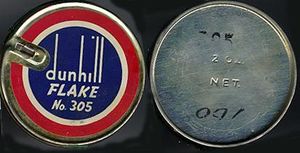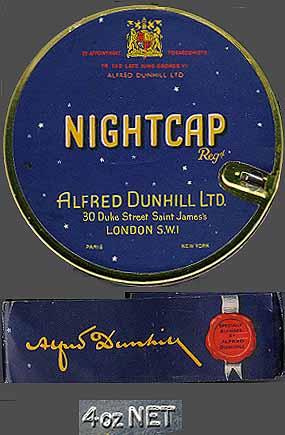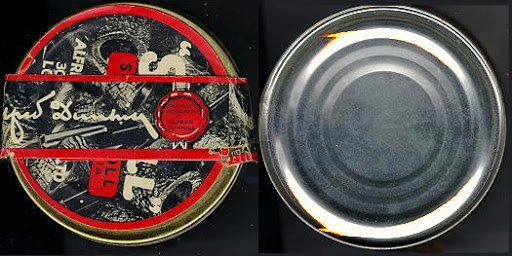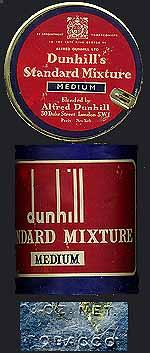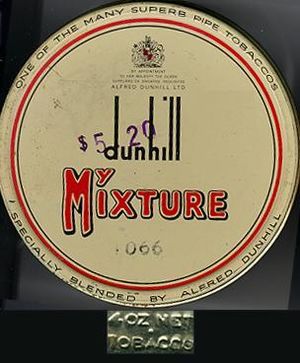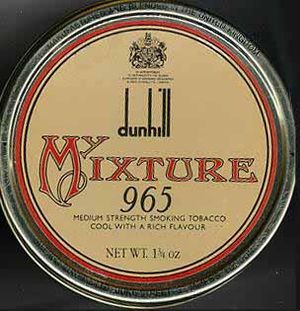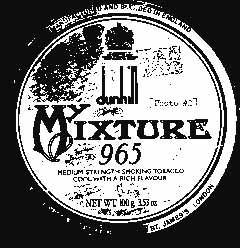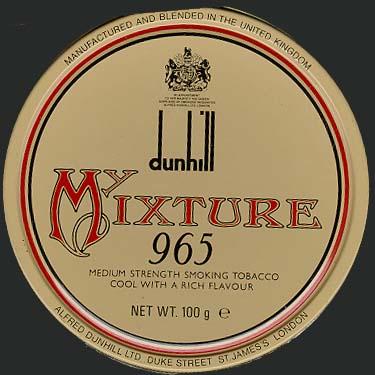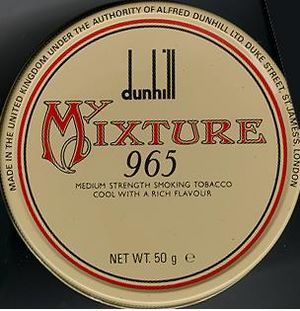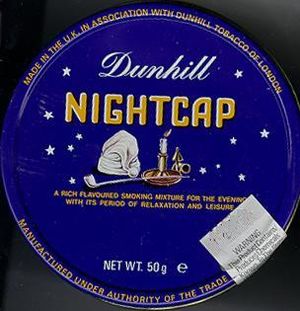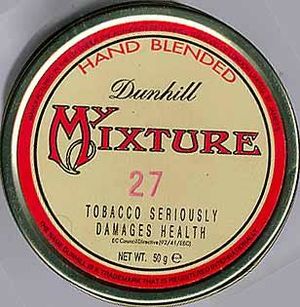On Dunhill Tinned Tobacco
ON DUNHILL TINNED TOBACCO, John C. Loring (9/1/97)
Contributed by Jean-Christophe Bienfait
please note that to some extent this paper has been superseded by my Dating English Tinned Tobacco Paper
There was a time when Dunhill tinned tobacco was not the finest available, after all pipe smoking preceded Alfred Dunhill by several centuries. But to steal a phrase, once Alfred put his apron on there was 'none better'.
It appears from a photograph attributed to 1909 that initially Dunhill tobaccos were sold in non-vacuum half pound and pound tins bearing a My Mixture labels in two different but similar styles and similar to that used for the following half century .
World War I saw the introduction of the ‘knife-lid’ or ‘cutter top’ tin a tin which allows for long term storage and transportation,
and with that the introduction to the world of the now classic Dunhill blends. A ‘knife-lid’ or ‘cutter-top’ tin is an air tight container with two tops. The inner thin metal top seals the tobacco in the container. The outer top which fits over the top portion of the container has a small sliding knife element which is used to open the sealed inner top. The knife element is activated by sliding it in about an eighth-inch from the edge. The outer top is then replaced over the container and pushed downward so that the knife element pierces the inner top. The outer top is then twisted all the way around the tin so that it fully cuts the inner top. Once done the inner top is removed and thrown away and the knife element is slid back out of harms way. The tobacco is now ready to be smoked with the outer top being used as a, non-airtight, cover.
From at least the early 1920’s Dunhill generally sold it’s tobacco in four ounce knife lid tins for between a $1.00 (Three Year Matured Virginia) to $2.50 (Royal Yacht & Cuba) with the average price being $1.50.
Most blends popular today were available then plus a number of mixtures which have since disappeared from general distribution including, Super, Savory’s, Baby’s Bottom, Durbar, Prince of Wales, Harmony, and Shell. But times were not free from inflation for by the mid ‘20s Three Year Matured had soared to $1.25. Then however, blend prices stabilized, increasing only modestly over the next forty years.
Eight ounce and two ounce knife lid tins were also available for the more popular blends. And while pressed flake blends normally came in two ounce tins, there were also larger containers. While I have seen a one pound non-knife lid My Mixture round tin dating from '20s - '30s but I am not sure that that weight was ever available as a knife lid. In addition one ounce, lead foil sealed and pressurized packets and later ‘coin-twist’ tins of that size were also sold .
It appears that from the twenties through the fifties the 4 ounce knife lid tin underwent very little change in appearance. Generally speaking, as pictured earlier and below, they were four inch diameter, two inch tall tins although some blends (e.g. Ye Olde Signe and Shell) did use a three inch by two and three quarter inch container. The bottom of the tins, at least in the '40s and '50s were stamped "MADE IN GREAT BRITAIN" (occasionally preceded with CONTAINER") with no weight stamping.
For the widely distributed blends (including My Mixture 965) paper labels, which varied for each blend, surrounded the tin and covered the outer top. Further, the outer top was ‘taped’ to the container with a paper band bearing Alfred Dunhill’s signature usually accompanied by a facsimile red seal.
The limited distribution My Mixture blends differed in this regard only in that the labeling was uniform save for a hand written blend number on the side label.
Very early on Dunhill apparently became a favorite of Edward, Prince of Wales. The company named one of its blends in the Prince's honor and in 1921 the Prince gave the company a Royal Warrant. By 1927, if not earlier Dunhill made that warrant a part of the labeling for some blends including London Mixture and Old Colonial. Although interestingly, the warrant was never added to the Prince of Wales label.
The warrant was most certainly removed with the abdication, but then, in 1938, a Royal Warrant was received from the new King George VI and that warrant was added to labels ("By Appointment [Royal Crest] Tobacconist [/] To H.M. the King").
Other then the then relatively recent Royal Warrant from the King, the addition of a "War Time Packing M4A" imprint, and three other points noted below the My Mixture #10 tin from World War II pictured below is probably typical of the 4oz My Mixture knife lids from the twenties through the fifties.
A 1927 Dunhill catalogue pictures My Mixture tins that differ with the World War II tin in two additional aspects. Specifically the My Mixture Number is to the left, rather then to the right of "My Mixture" on the side label and directly under "My Mixture" is the legend "Manufactured in England". Another earlier My Mixture tin I have inspected shows a third difference. The side address label panel of that tin has a after "30", instead of references to the Paris and New York stores (which may not have then existed) there is "Telephone: GERRAD 5189" at the left and "Telegrams: "SALAAMS, LONDON"" at the right, and lastly "copyright" is printed at the lower left side.
Following the war Dunhill continued to use the Royal Warrant "By Appointment [Royal Crest] To H.M. The King" on it’s tins which included then new blends such as Early Morning, NightCap, and Aperitif, but
apparently for the first time the warrant was placed on the top, rather then the side, label.
When the King passed away in 1953 Dunhill continued to display the warrant but removed the direct reference to the deceased monarch ("By Appointment [Royal Crest] Tobacconists"). A few year’s later the tin label was again revised to read "By Appointment [Royal Crest] Tobacconists [/] To The Late King George VI". This form continued in use through the early '60s.
However, all of the above may not necessarily apply with respect to two ounce knife lid tins. For instance a two ounce tin of Flake # 305 which can be reliably dated to the early ‘50s does not display the Royal Warrant and does have a weight stamp on the bottom.
The ‘60s (or possibly the late '50s) however, saw a lighter metal tin construction (see Shell tin above), the standard 4 inch diameter 4 ounce knife lid tin was reduced to a 3 3/4 inch diameter and for the first time the weight was stamped on the bottom of the 4 oz tin (see NightCap tin).
In addition there was a change in the outer tin top construction. Previously it had been made of a dull gold or gold/silver metal with no 'roll' at the lower lip (the top two pictured lids) or beginning in the early '50s, with a roll (bottom right), however the lid for the new 3 3/4 inch diameter tin was made of a bright shinny gold tone metal with a pronounced 'roll' at the lower lip (bottom left).
Similar changes were made in the larger 8 ounce tin.
With prices spiraling up to between $2.50 to $3.50 for a four ounce tin, the mid to late ‘60s saw the first major packaging change in Dunhill tins in nearly a half century with the replacement of the 4 ounce paper labeled knife-lid tins with 4 inch diameter, 2 inch tall painted ‘coin-twist’ tin with the weight in ounces stamped on the bottom. In addition the warrant on the label was changed to read "[Royal Crest] By Appointment [/] To Her Majesty the Queen [/] Suppliers of Smokers’ Requisites". The My Mixture tin labels were further changed by eliminating the facsimile red seal and introducing the long tail "dunhill"
It should be noted however, that the changeover from knife-lid to coin twist tins was gradual, for instance the Dunhill’s 1968/69 wholesale catalogue pictures four four ounce knife lid tins and only three four ounce coin twist tins.
In the decade that followed the British tobacco industry began to integrate into the common market as reflected by the change in the bottom weight stamping being changed from ounces to both grams and ounces. Part and parcel of the stamping change in the late ‘70s, Dunhill (and other blenders) reduced the tobacco content of it’s tins by more then 10% (with no reduction in price) going from a 4 ounce tin to a 100 gram/3.53 ounce tin.
Through the late ‘70s as Dunhill tins invariably advised, the tobacco contained therein was "Blended By Alfred Dunhill" or " Manufactured and Blended in England By Alfred Dunhill" or words to that effect. The "My" of "My Mixture" had a double connotation of personalization. Regretfully that ‘hands-on’ blending tradition ended in the late ‘70s when the Dunhill farmed out blending to one or two independent blender (believed by many to have been McConnells and/or Murrays). Reflecting this the tin label was changed to read simply "Manufactured And Blended In England" (suggesting McConnells as the blender) or "Manufactured and Blended In The United Kingdom" (suggesting Murrays of Northern Ireland as the blender) but in either case ‘by Alfred Dunhill’ was dropped. With respect to the My Mixture tins the "My Mixture" font which had gone virtually unchanged from 1909 was replaced by a ‘new’ old fancier look that had been previously used on occasion (see the photo above of the outer bag for the one ounce 965 packet).
Initially, these changes were done with a paper label having the tobacco weight in ounces or grams and ounces
but shortly a painted tin was introduced with weight measurements in grams, followed by a lower case "e" (apparently a common market reference) and uniformly marked "Blended In The United Kingdom" (it is believed that the uniform use of "United Kingdom" does not rule out the continued use of McConnels as one of the independent blenders during the eighties and rather stems from a natural corporate desire to have uniform labeling). In addition, the weight stampings were eliminated from the tin bottoms and the four ounce coin twist tin type was flattened a half inch to a one and a half inch height and widened to about an inch to a four and seven eighths inch diameter.
While I have attempted to be fairly mechanical about the late seventies switch to outside blenders, in fact to Dunhill tobacco smokers it was an event akin to the JFK assassination, there’s hardly a pipe smoker that can’t readily recall that horrible occasion when the first new tin was ‘popped’ only to discover the tragic disappearance of the wonderful aroma of mature tobacco.
In the early ‘90s, reflecting the times, the Royal Warrant was removed from the tins and "Manufactured and Blended In The United Kingdom" was changed to "Made In the United Kingdom Under The Authority Of Alfred Dunhill LTD".
Many smokers believe that contemporaneous with this change in tin styles Murrays or Rotherman-Murrays became the sole blender of all the widely distributed blends. A few years later, circa 1994, reflecting the Dunhill corporate restructuring, the manufacturing tin nomenclature was changed again to "Made in the U.K. in Association with Dunhill Tobacco of London".
Today Dunhill tinned tobaccos remain among the very finest of English tobaccos, but reflecting the demise in quality of all English blends over the past fifteen years, the widely distributed Dunhill blends are in fact only a shadow of their former selves. Some lay the blame on the change to an independent blender, other lay the blame on a cost-conscience English tobacco industry that a decade or two ago began to curtail the aging of tobacco before and after blending, and others still lay the blame on the lack of some previously available tobaccos such as Syrian latikia. Other’s just hoard their older tins and pray that they will find more.
There is however, one bright spot, Dunhill continues to make available from its Duke Street store (only) the dozens of "My Mixture" blends not otherwise widely distributed. While these "My Mixture" blends run twice the price of say 'NightCap' or '965' in the United States, to many this cost differential is nominal for many of these Duke Street 'My Mixture' blends come remarkably close to the quality of what once was. For instance you can comfortably alternate between a recent and a twenty year old tin of No. 73 (a heavy latakia blend) without cursing. Older is better but the new is more then respectable. And while blend No. 27 is a bit too mild for my taste, in truth I find myself always coming back for another bowlful just to savor the delicate blending style that I thought long past. Reportedly the 'My Mixture' blends available from the Dunhill Duke Street store are the product of a single individual who carefully follows the My Mixture formulas, selects the tobaccos to be blended from a variety of sources and in the process most thankfully demonstrates that the 'gentle art' remains quite possible today.
Back to Loring's articles here

